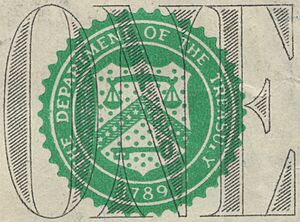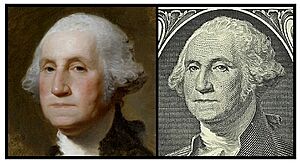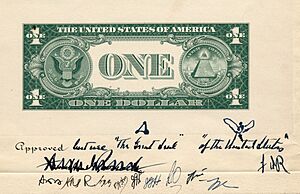United States one-dollar bill facts for kids
| (United States) | |
|---|---|
| Value | $1 |
| Width | 6.14 inches ≈ 156.1 mm |
| Height | 2.61 inches ≈ 66.3 mm |
| Weight | Approx. 1 g |
| Paper type | 75% cotton 25% linen |
| Years of printing | 1929 – present (Small size) |
| Obverse | |
 |
|
| Design | George Washington |
| Design date | 1963 |
| Reverse | |
 |
|
| Design | Great Seal of the United States |
| Design date | 1935 |
The United States one-dollar bill ($1) is the lowest value paper money in the U.S.. It has been used since 1876. On the front, you'll see a picture of George Washington, who was the first President of the United States. This picture is based on a famous painting from 1796.
On the back of the dollar bill, you can see the Great Seal of the United States. The design of the dollar bill is the oldest one still being made for U.S. money. The front design we see today first appeared in 1963. Before that, dollar bills were called Silver Certificates.
The phrase "In God We Trust" was added to all U.S. money by law in 1955. It first appeared on paper money in 1957. A dollar bill usually lasts about 6.6 years before it gets too worn out. In 2009, about 42% of all U.S. paper money made was one-dollar bills. By the end of 2019, there were 12.7 billion one-dollar bills being used around the world.
Contents
What's on the Front of the Dollar Bill?



The front of the one-dollar bill shows a picture of George Washington in the middle. This has been the design since 1869. The oval around George Washington is decorated with bay laurel leaves.
The Federal Reserve Seal
To the left of George Washington, there is a special seal for the Federal Reserve District. This seal shows which Federal Reserve Bank printed the bill. A capital letter (A–L) inside the seal tells you which of the twelve Federal Reserve Banks it came from. The bank's number (like 1 for A, 2 for B) also appears four times in the corners of the bill's open space.
For dollar bills and two-dollar bills, this seal is still used. However, on higher value bills, there is now a single Federal Reserve System seal.
The Treasury Department Seal
To the right of George Washington, you'll find the Treasury Department seal. This seal has several symbols:
- Scales: These stand for justice.
- Chevron with thirteen stars: This represents the original thirteen colonies of the U.S.
- Key: This symbol means authority and trust.
- The year 1789: This is when the Department of the Treasury was created.
Since 1969, dollar bills have used a simpler Treasury seal. The words on it are now in English instead of Latin.
Signatures and Dates
Below the Federal Reserve Bank seal, you'll see the signature of the Treasurer of the United States. Below the Treasury Department seal, there is the signature of the Secretary of the Treasury.
To the left of the Secretary's signature, you'll find the series date. A new series date appears when there's a change in the Secretary of the Treasury or the Treasurer. It also changes if the bill's design is updated.
Other Details on the Front
Around the edges of the bill, you can see olive branches wrapped around the number "1". A small number and letter combination is at the bottom right. A small letter is also at the top left corner.
If you see "FW" before the bottom right number, it means the bill was printed in Fort Worth. This city has a special printing facility. If there is no "FW", the bill was printed in Washington, D.C..
What's on the Back of the Dollar Bill?

The back of the one-dollar bill has a detailed design. It shows both sides of the Great Seal of the United States. These seals are on the left and right sides of the large word "ONE" in the middle. A smaller "ONE" is also placed over the number "1" in each of the four corners.
At the top of the bill, it says "THE UNITED STATES OF AMERICA". At the bottom, it says "ONE DOLLAR". Above the central "ONE" are the words "In God We Trust". This became the official motto of the United States in 1956. Below the left seal, it says "THE GREAT SEAL". Below the right seal, it says "OF THE UNITED STATES".
The Great Seal was first designed in 1782. It was added to the dollar bill in 1935. The pictures used are the official government versions that have been around since the 1880s.
The Left Side of the Great Seal
The left side of the seal shows an unfinished pyramid with 13 steps. These steps stand for the original 13 states. At the top of the pyramid, there's an Eye of Providence inside a triangle. This eye represents God watching over the nation.
At the bottom of the pyramid, you can see the Roman numerals MDCCLXXVI. This is 1776, the year of American independence from Britain. Above the pyramid, a Latin phrase says "ANNUIT COEPTIS". This means "He favors our undertaking." Below the pyramid, a banner says "NOVUS ORDO SECLORUM". This means "New Order of the Ages" and refers to the new era of America.
To the left of this seal, a line of 13 pearls goes towards the edge of the bill.
The Right Side of the Great Seal
The right side of the seal features a bald eagle. This eagle is the national bird and a symbol of the United States. Above the eagle, there are 13 stars arranged in a six-pointed star. The eagle's chest has a shield with 13 stripes, like the American flag. These stars and stripes also represent the 13 original states.
The eagle holds a ribbon in its beak that says "E PLURIBUS UNUM". This Latin phrase means "Out of many [states], one [nation]". It was a very important motto for the U.S. until 1956. Both "E Pluribus Unum" and "Annuit coeptis" have 13 letters.
In its left claws, the eagle holds 13 arrows. In its right claws, it holds an olive branch with 13 leaves and 13 olives. The arrows stand for the power of war, and the olive branch stands for peace. To the right of this seal, another line of 13 pearls goes towards the edge of the bill.
Collecting Dollar Bills
Most green seal dollar bills are not worth much to collectors, unless they have big printing errors. However, some bills have become interesting to people.
The 1963 Dallas Bill
In 1963, dollar bills were made for the Eleventh Federal Reserve District in Dallas. These bills had the letter "K" because K is the 11th letter of the alphabet. Some people noticed that these bills, with the number "11" and a "K" in a black seal, appeared around the time President John F. Kennedy was shot in Dallas in November 1963. But it's important to know that this bill was not made to remember the event, and there was no real connection between them.
The Joseph W. Barr Signature
Joseph W. Barr was Secretary of the Treasury for only 31 days in 1968–69. His signature appeared only on the 1963B dollar bill. Some collectors thought these bills might be rare because he was in office for such a short time. However, many of these bills were printed (over 458 million!), so they are actually quite common.
Bills with Interesting Serial Numbers
Some dollar bills are collected because of their unique serial numbers.
- Radar notes: These are also called "palindrome" notes. Their serial numbers read the same forwards and backward (like 1234321).
- Low serial numbers: Bills with very low numbers, or many of the same or repeating digits, can also be special.
- Replacement notes: These bills have a star next to the serial number. The star means that there was a printing error on another bill, and this one was printed to replace it. Star notes can sometimes be more valuable, depending on their condition and how rare they are.
Should the Dollar Bill Be Replaced?
Today, the one-dollar bill is used much more often than the dollar coin. The U.S. Government has tried many times to encourage people to use dollar coins instead. Some groups want to get rid of the dollar bill completely, while others want to keep it.
In 2012, a group in the House of Representatives discussed replacing the dollar bill. A report from the GAO said that switching to dollar coins could save $4.4 billion over thirty years. However, most Americans do not want to stop using dollar bills. Recent laws passed by Congress have stopped the Treasury Department from spending money to redesign the one-dollar bill. This is partly because of how it might affect vending machines and other businesses.
Images for kids
See also
 In Spanish: Billete de un dólar estadounidense para niños
In Spanish: Billete de un dólar estadounidense para niños


